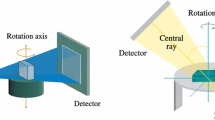Abstract
This paper describes an improved block-cyclic inversion (BCI) method [1] for the three-dimensional (3D) inverse Radon problem: a major problem in computer tomography. A spiral-fan scheme of scanning (SFSS) and the cylindrical domain of inspection are taken. The 3D problem is reduced by decomposition to the series P of 2D problems (with the same Radon matrix). The account taken for a priori information about the circular FSS invariance allows the direct block-cyclic inversion of the Radon matrix by use of the Greville-1 block algorithm instead of the classic block Toeplitz inversion (BTI) [2,3], based on the concept of the Teoplitz range. The performance of the BCI versus BTI algorithm is better by a factor N both at the stage of preliminary inversion and in the flow due to vectorization. The required volume of memory is a sixth, but the main advantage of BCI is its simplicity of implementation, because of the absence of the degeneration problem, which is inherent in the classic method, as well as a higher stability. This has allowed a space resolution of up to 201 × 201. In 101 × 101 resolution, the counting time of a 2 s order in the variant of the PC PENTIUM-4 model (language Visual Fortran 90), and the time of the Radon matrix inversion itself is 20 s with the stability coefficient of ∼10 (in L 2 metrics), 75 (in C metrics), i.e., by a factor of 3–10 better than in [23]. This is achieved due to the filtration of noise in the right-hand part, smoothing the solution itself and some other improvements of the algorithm. The problem mentioned in [1] was also solved. The obtained results can be applied to the software support of 4th generation tomographs.
Similar content being viewed by others
References
A. V. Khovanskii and A. M Demkin, “Methods of Bloc-Cycling Inversion in Computer Tomography,” Mat. Mod. 23(1), 51–64 (2001).
V. V. Voyevodin and E. E. Tyrtyshnikov, Calculation Processes with Toeplitz Matrices (Nauka, Moscow, 1987) [in Russian].
F. Natterer, The Mathematics of Computerized Tomography (Wiley, New York, 1986; Mir, Moscow, 1990) [in Russian].
A. V. Likhachev and V. V. Pikalov, “Synthesized Algorithm of Three-Dimensional Tomography,” Mat. Mod. 10(1), 1–73 (1998).
V. V. Pikalov, I. G. Kazantsev, and V. P. Golubiatnikov, Vopr. Program. 7(2), 180–184 (2006).
A. N. Tikhonov and V. Ya. Arsenin, Methods for Solving Non-Correct Problems (Nauka, Moscow, 1979) [in Russian].
A. N. Tikhonov, V. Ya. Arsenin, and A. A. Timonov, Mathematical Problems of Computer Tomography (Nauka, Moscow, 1987) [in Russian].
I. N. Troitskii, Statistical Theory of Tomography (Radio i Sviaz’, Moscow, 1989) [in Russian].
D. K. Faddeyev and V. N. Faddeyeva, Computational Methods of Linear Algebra (Fizmatlit, Moscow, 1963) [in Russian].
G. A. Fedorov and S. A. Tereshchenko, Computational Emission Tomography (Energoatomizdat, Moscow 1990) [in Russian].
G. Hermen, Reproduction of Images by Projections: Fundamentals of Reconstructive Tomography (Mir, Moscow, 1983) [in Russian].
A. V. Khovanskii, “Methods for Constructing Almost Hadamard Circulants and Their Possible Applications,” Mat. Mod. 8(1), 69–76 (1996).
A. V. Khovanskii, “The Greville Algorithm and Its Applications in Transmission Computer Tomography,” Mat. Mod. 8(11), 109–118 (1996).
V. V. Pikalov and T. S. Mel’nikova, Low Temperature Plasma, Vol. 13: Tomography of Plasma (Nauka, Novosibirsk, 1995) [in Russian].
Y. Abaffi and E. Spedikato, Mathematical Methods for Linear and Non-Linear Equations, Projection ABS-Alogirthms (Mir, Moscow, 1996) [in Russian].
Seismic Tomography, Ed. G. Nolet (Mir, Moscow, 1990) [in Russian].
R. E. Blahut, Fast Algorithms for Digital Signal Processing (Mir, Moscow, 1989) [in Russian].
V. Yu. Terebizh, Introduction in Statistical Theory of Inverse Problems (Fizmatlit, Moscow, 2005) [in Russian].
N. S. Bakhvalov, Numerical Methods (Nauka, Moscow, 1975) [in Russian].
G. Kramer, Mathematical Methods of Statistics (Nauka, Moscow, 1975) [in Russian].
F. R. Gantmakher, Theory of Matrices (Nauka, Moscow, 1967) [in Russian].
T. Kohonen, Associative Memory (Mir, Moscow, 1980) [in Russian].
K. Brammer and G. Siffling, Kalman-Bucy Filters (Nauka, Moscow, 1982) [in Russian].
Author information
Authors and Affiliations
Corresponding author
Additional information
Original Russian Text © A.V. Khovanskii, 2012, published in Matematicheskoe Modelirovanie, 2012, Vol. 24, No. 5, pp. 65–80.
Rights and permissions
About this article
Cite this article
Khovanskii, A.V. Development of the block-cycling inversion in computer tomography. Math Models Comput Simul 4, 611–621 (2012). https://doi.org/10.1134/S2070048212060075
Received:
Published:
Issue Date:
DOI: https://doi.org/10.1134/S2070048212060075
Keywords
- (parallel processing
- complexity
- accuracy
- stability) of the algorithm
- computer tomogra-phy
- method of Fast Fourier Transform (FFT)
- BCI
- BTI
- Glassman-de Boor
- Greville
- least squares
- neuron networks
- back projection
- etc.
- Radon (problem
- matrix
- image
- operator
- projection
- equation)
- theorem of Wedderburn
- Gauss-Markoff
- convolution
- (fan-spiral
- parallel) scanning scheme




